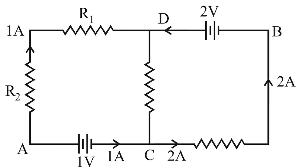Current Electricity
- The thermo e.m.f E in volts of a certain thermocouple is found to vary with temperature difference θ in °C between the two junctions according to the relation
E - 30θ - θ² 15
The neutral temperature for the thermocouple will be
-
View Hint View Answer Discuss in Forum
E = 30Ω - θ² 15
For neutral Temperature, de/dθ = 0
0 = 30 - (2/15)θ
∴ 0 = 15 x 15 = 225° C
Hence, neutral temperature is 225°C.Correct Option: D
E = 30Ω - θ² 15
For neutral Temperature, de/dθ = 0
0 = 30 - (2/15)θ
∴ 0 = 15 x 15 = 225° C
Hence, neutral temperature is 225°C.
- Consider the following two statements:
(A)Kirchhoff's junction law follows from the conservation of charge.
(B)Kirchhoff's loop law follows from the conservation of energy.
Which of the following is correct?
-
View Hint View Answer Discuss in Forum
Junction law follows from conservation of charge and loop law is the conservation of energy
Correct Option: D
Junction law follows from conservation of charge and loop law is the conservation of energy
- In producing chlorine by electrolysis 100 kW power at 125 V is being consumed. How much chlorine per minute is liberated? (E.C.E. of chlorine is 0.367×10–3 kg / C)
-
View Hint View Answer Discuss in Forum
I = P = 100 × 103 A = 105 A V 125 60
E.C.E. = 0.367 × 10-6 kg C -1
Charge per minute = (I × 60) C= 105 × 60 C = 6 × 106 C 125 125
∴Mass liberated= 6 × 106 × 0.367 × 10-6 125 = 6 × 1000 × 10-3 = 17.616 × 10-3kg 125
Correct Option: C
I = P = 100 × 103 A = 105 A V 125 60
E.C.E. = 0.367 × 10-6 kg C -1
Charge per minute = (I × 60) C= 105 × 60 C = 6 × 106 C 125 125
∴Mass liberated= 6 × 106 × 0.367 × 10-6 125 = 6 × 1000 × 10-3 = 17.616 × 10-3kg 125
- In the circuit shown in the figure, if potential at point A is taken to be zero, the potential at point B is

-
View Hint View Answer Discuss in Forum
Current from D to C = 1A
∴ VD – VC = 2 × 1 = 2V
VA = 0
∴ VC = 1V,
∴ VD – VC = 2
⇒ VD – 1 = 2
∴ VD = 3V
∴ VD – VB = 2
∴ 3 – VB = 2 ∴ VB = 1VCorrect Option: D
Current from D to C = 1A
∴ VD – VC = 2 × 1 = 2V
VA = 0
∴ VC = 1V,
∴ VD – VC = 2
⇒ VD – 1 = 2
∴ VD = 3V
∴ VD – VB = 2
∴ 3 – VB = 2 ∴ VB = 1V
- A thermocouple of negligible resistance produces an e.m.f. of 40 µV/°C in the linear range of temperature. A galvanometer of resistance 10 ohm whose sensitivity is 1µA/div, is employed with the termocouple. The smallest value of temperature difference that can be detected by the system will be
-
View Hint View Answer Discuss in Forum
1 division = 1µA
Current for 1°C = 40μV/10 = 4μA
1μA =1/4 °C = 0.25°C.Correct Option: D
1 division = 1µA
Current for 1°C = 40μV/10 = 4μA
1μA =1/4 °C = 0.25°C.

